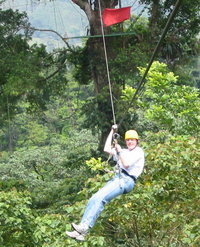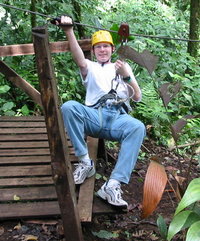Zip-line
|
|

A zip-line, aerial runway, death slide or tyrolean crossing consists of a pulley suspended on a cable mounted on an incline. They are designed to enable a user to traverse from the top to the bottom of the inclined rope or cable, by holding onto the freely moving pulley. Most often, these contraptions are used as a means of entertainment.
Zip-lines come in all forms and shapes. Sometimes they are short and low, intended for childs play. This kind is sometimes found on playgrounds. Longer and higher rides are often found at outdoor adventure camps where they are usually one element on a larger challenge course, or ropes course.
Small zip-lines can be ridden with a hand car (pulley) that is held on to and the person hangs underneath. Larger rides sensibly necessitate that the rider wear a safety harness. These rides can be very high, starting at a height of over thirty feet, and travelling well over two hundred feet.

Users of zip-lines must have means of stopping themselves. Typical mechanisms include a mat or netting at the lower end of the incline; a bungee cord arrester, which slows then stops the pulley's motion; of the use of a cable suspended between two similarly high points, sagging in the middle, such that the user comes to rest at the low point after a period of oscillation. For children's versions, the zip-line is usually not set up a steep incline, so the speeds are kept relatively low, negating the need for a means of stopping.
It should be noted that proper knowledge of ropework is required in order to construct a zip-line; attempts to build a zip-line without the requisite knolwege may lead to the construction of a dangerous contraption capable of injuring users.
Zip-line-instructions.png
Gallery
Zip-line-fun-ride.jpg
Zip-line-handle-bars.jpg
Zip-line-tensioner.jpg
Zip-line-trolley.jpg
See also
External Links
- TST Toys: Aerial runway hardware (http://www.tsttoys.com)
- Scoutbase: Advise on rope constructed rides (http://www.scoutbase.org.uk/ps/activities/factfile.php?ID=2)
